
Right. My very last day off in London, the first Sunday in September. No longer could I put off the choice between the Tower of London (including Tower Bridge) and Greenwich (the National Maritime Museum, above, and the Royal Greenwich Observatory). As an ex-astrophysics type, I really couldn't not go and see the observatory at Greenwich. So I decided to do one-and-a-half for the price of one and took a cruise down the Thames, from Westminster to Greenwich. That way I could at least see the Tower and the Bridge as we sailed past ...

This, the Royal Air Force Memorial, is near Westminster Pier (where the tour started from), looking east over the Thames. It's a pretty grand structure, what with it's great gilded eagle grasping a globe in its claws. Because of its grandness, I thought it must have been yet another tribute to the few, or something along those lines. But it was actually unveiled in 1923, and is dedicated to the British and British Empire airmen who died in the First World War (a later inscription updates it for the Second). According to the RAF Benevolent Fund, it was originally supposed to face the other way around (towards Whitehall), but the design was changed to 'allow the eagle to face across the river, symbolically to France'. But it's actually facing Germany, not France, which I think is a different symbolism altogether ...
(N.B. It was somewhere around here that I saw the Dragon Rapide.)

This is HMS Belfast, a Town-class cruiser which took part in the Second World War (including North Cape and D-Day) and the Korean War. It's now a museum ship, part of the Imperial War Museum. Actually, I probably would preferred to see this than the Tower!
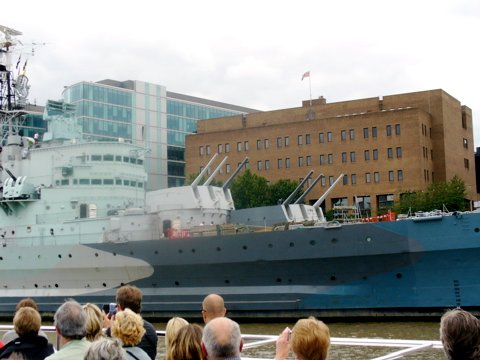
There's not actually much left of what was once the greatest navy on the planet. As far as I can tell, this is the largest ship remaining from the Royal Navy of the Second World War. It's a bit of a shame, really, that none of those grandly-named battleships and aircraft carriers have survived. Of course they must be very expensive to maintain, but the Americans seem to have done much better in preserving their naval heritage.
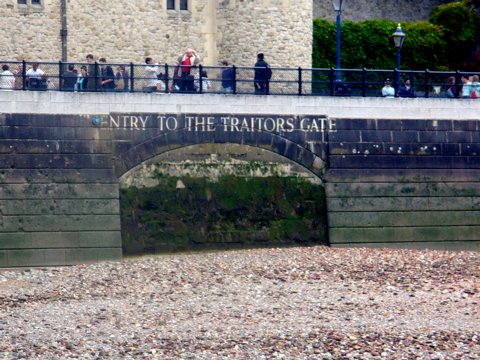
The Traitor's Gate to the Tower of London (my photos of which are pretty average, and anyway everyone knows what it looks like). It's bricked up now, which I suppose means they aren't expecting any more traitors.
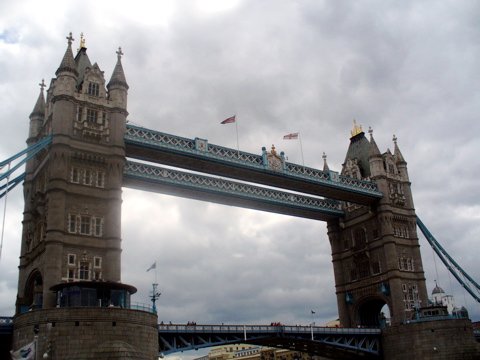
Approaching Tower Bridge. And yes, I must admit that 6 months ago I thought this was London Bridge!
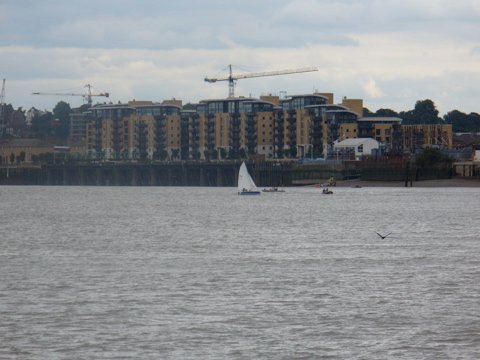
The trip down the Thames was a great way to see a lot of London in a short time -- old docks, replica sailing ships, ancient pubs, waterfront police stations, David Bowie's flat (or so the tour guide said). But it was very overcast and the photos are very murky, so I'll just show this one of somebody messing about on the river, off Deptford.
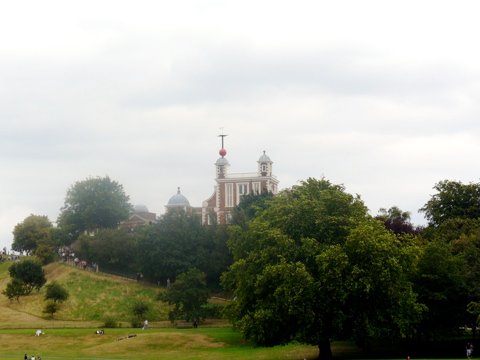
Once I alighted at Greenwich, I made straight for the hill in Greenwich Park, where the Royal Observatory, Greenwich, stands. (This should not be confused with the Royal Greenwich Observatory, which moved from Greenwich to Herstmonceaux Castle after the war, and then to the Institute of Astronomy at Cambridge. But then, the RGO closed in 1998 so I don't suppose many people would confuse it ...)
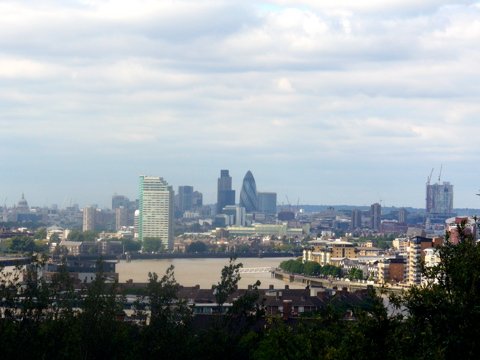
There are fine views from the hill. This is looking back towards the City (the Gherkin is at the centre, St Paul's is on the left, on the horizon, the Isle of Dogs in the foreground on the right).
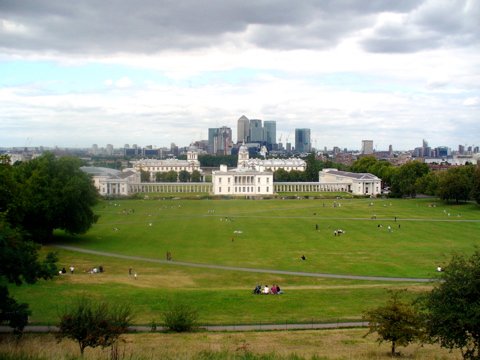
Directly across the river, towards the Isle of Dogs and Canary Wharf.

And behind the Greenwich Power Station, the fabled The O2.
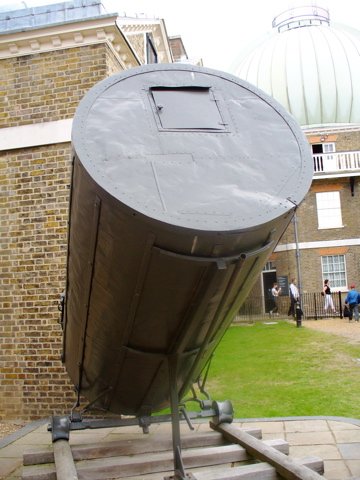
This is all that remains of William Herschel's 40-ft. reflecting telescope, first used in 1789 at Slough, and which was at one time the largest telescope in the world. The mirror was 48-inch in diameter; the original is in the possession of the Science Museum. Unfortunately, the telescope was not very easy to use: it was just too big and bulky to be moved easily. The Slough Museum has a model of how it would have been used.
So the big telescope didn't fulfill expectations -- and they were high, I expect: Herschel was probably the greatest astronomer of his day, the discoverer of Uranus, the solar system's motion through space, the shape of the Milky Way, infrared radiation, and many other things. He did manage to find two new moons of Saturn with it, though. It was pulled down by his son, John Herschel (an even greater astronomer than his father), and later in the 19th century crushed by a falling tree!

The Observatory with various domes and doors for transit instruments. Inside are various exhibits and restored rooms, showing what the place was like when it was a working observatory. The pride of the Observatory is clearly their collection of beautiful 18th century Harrison marine chronometers (and I'm sure the curators owe Dava Sobel a pint or two for writing Longitude), but I actually enjoyed following the story of John Flamsteed, the first Astronomer Royal, more -- the compilation of the great star catalogue which bears his name, with his wife as unpaid and long suffering assistant, the impatience of the scientific community for it to be published and hence Edmund Halley's unauthorised publication of a preliminary version, Flamsteed's burning of every copy he could lay his hands on, and the catalogue's final, authorised but posthumous publication in 1725 as the Historia Coelestis Britannica!
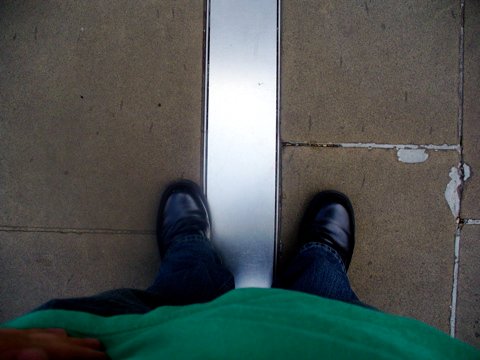
Of course, I couldn't resist straddling the Prime Meridian, with one foot in the eastern hemisphere and one in the western ...
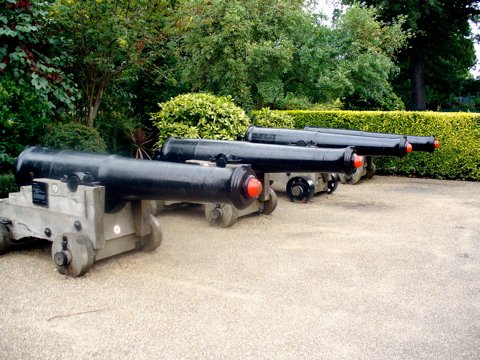
Down the hill again, at the National Maritime Museum. This was a most excellent museum -- royal barges, giant propellers, a ship navigation simulator, lots of Nelson's navy type stuff (I must get up to date on my N. A. M. Rodger) and an amazing collection of Admiralty ship models, mainly from the 18th century. But ... no photography allowed inside. So instead, here are some cannons.

Captain Cook, approximately the 44th European to discover Australia, in an unusually heroic stance.

As I left the Museum, it suddenly occurred to me that I had no idea how to get back to Bloomsbury. My trip down the river had been only one way, and Greenwich was far enough east to be off the little map I had with me, so I was a bit lost. I knew there was no Tube here, and was about go and investigate what this DLR thingy was all about, or there was National Rail I suppose. But then out the front of the Museum I saw a bus stop, and so on the off chance I had a look to see if the buses went anywhere useful. And as it happened, one of the buses went all the way to Russell Square! Too easy. So, above is a snap out the front top window of a 188, going down Nelson Road in the middle of Greenwich.
![]() This work is licensed under a Creative Commons Attribution-NonCommercial-NoDerivatives 4.0 International License.
Permissions beyond the scope of this license may be available at http://airminded.org/copyright/.
This work is licensed under a Creative Commons Attribution-NonCommercial-NoDerivatives 4.0 International License.
Permissions beyond the scope of this license may be available at http://airminded.org/copyright/.



Pingback:
Greenwich Park, el decano entre los Parques Reales de Londres